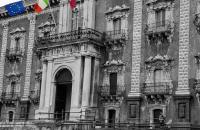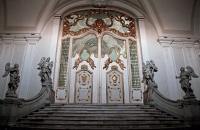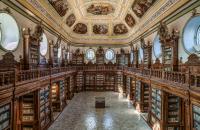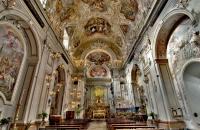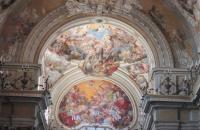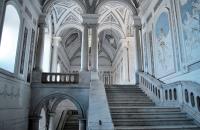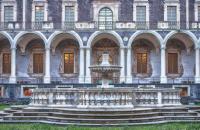About The University
The foundation of the University of Catania, the oldest in Sicily, dates back to 1434, when the king of Spain, Alfonso of Aragon (who was also King Alfonso I of Sicily) authorised the establishment of a Studium generale with the privilege of issuing legally valid academic titles. In 1444, the first four faculties of Medicine, Philosophy, Canonic and Civil Law and Theology and Arts were established. Students began to attend classes in 1445, however it was not until two centuries later that the university gained its own establishment in Piazza Università.
The former building was completely destroyed by an earthquake in 1693 and students were left without a place to continue their study. In the interim period before it was rebuilt, the resourceful students, unperturbed by such events and endowed with infinite determination, transferred classes to wooden huts near the harbour. The new building, designed by Giovan Battista Vaccarini, is a magnificent monument of Baroque architecture. Today the university buildings are spread throughout the city, with a contrast between the modern, hi-tech “University City”, and numerous historical buildings in the old city centre. It offers an attractive portfolio of academic titles and is committed in the creation of a “laboratory” where the ancient Mediterranean culture meets the new technologies, in order to offer advanced training experience. There are about 45,000 students enrolled at the University of Catania. The organization of the teaching is handled today by 17 departments, by the Faculty of Medicine, and by two special didactic units established in the decentralized offices of Ragusa (Modern Languages) and Syracuse (Architecture). A special didactic unit is also the school of excellence "Scuola Superiore di Catania", a higher education centre of the University of Catania conceived in 1998 to select the best young minds and offer them a course of studies including analysis, research and experimentation.
THE DEPARTMENT OF EDUCATIONAL SCIENCES
 The history of the Department of Educational Sciences at the University of Catania had its institutional foundation as the “Istituto Universitario di Magistero” in 1949. In 1990, the private “Magistero” became a public institution, integrated into the University as the tenth Faculty. In 1993, the graduate degree in Pedagogy was converted into the Science of Education degree, confirming its definitive organizational status in the Faculty itself.
The history of the Department of Educational Sciences at the University of Catania had its institutional foundation as the “Istituto Universitario di Magistero” in 1949. In 1990, the private “Magistero” became a public institution, integrated into the University as the tenth Faculty. In 1993, the graduate degree in Pedagogy was converted into the Science of Education degree, confirming its definitive organizational status in the Faculty itself.
Finally, in 1995, the latest institutional change: The “Faculty of Magistero” become integrated into the Faculty of Educational Science, no longer only organized for teachers' preparation but also for creating new professional-level opportunities for qualified educators in diverse social sectors, not only traditional schools.
Initiating in the academic years 2001/2002, a radical change was introduced in course implementation, also for the preparation of qualified professionals in the fields of Tourism and Psychology.
Didacticts and Research Centers
The Department of Educational Sciences includes approximately fifty professors and thousands of students distributed in three 1st level degree courses and two 2nd level courses.
The Department of Educational Sciences includes approximately fifty professors and thousands of students distributed in three 1st level degree courses and two 2nd level courses. The Department and its offices can be found in the heart of the historical city-center, at the Ex-Monastery of the
“Verginelle”, situated in front of the Benedettini Monastery (where the Department of Human Sciences is located). Other sites of the Department are Palazzo Ingrassia (Via Biblioteca, near Piazza Dante) and the original site of ‘Magistero’ in Via Ofelia.
At present, the total number of Professors is 50 (full, associate and researchers). Curricular and extra-curricular study is assured by the presence of a library: there is a total of 40 workstations and a simple all day access (all year round). The library provide a total number of 130,000 volumes (included Italian and foreign journals).
Department of Educational Sciences' research activities are involved in the following interdepartmental University Research Centers:
Center for Cretese Archeology Professors Dario Palermo and Orazio Palio are members of the Advisory Board
- Center for Research on Family and Children’s legal rights, which besides these interdisciplinary research activities also annually activates a course of specialization on these issues. Professor Santo Di Nuovo is member of the Advisory Board.
- Center for Documentation and Studies on Complex Organizations and Local Systems (CeDoc). Professors Giuseppe Santisi and Santo Di Nuovo are members of the Advisory Board.
- Center for Interdepartmental Research on Community University Engagement (CUrE). President Professor Roberta Piazza
THE DIPARTMENT OF HUMANITIES
The Benedictine Monastery of “San Nicolò”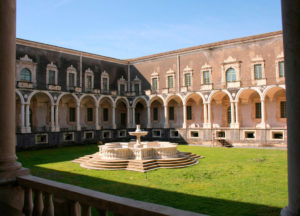
Nowadays it hosts the Department of Humanities (DISUM) of the University of Catania. The Monastery is a unique place that tells about the human and historic events of the city on the slope at the foot of Etna, from the ancient times until today. Guided tours from 9:00 to 17:00, starting every hour, and are organized by the association Officine Culturali.
Moreover, the association organizes the visit to the Church of Saint Benedict, Via Crociferi (Entrance from Via Teatro Greco 2). St. Benedict’s church is part of the cultural itinerary of the Historic Site of St. Benedict Monastery. It is an example of Baroque architecture in Catania. The Church of St.
Benedict was founded in 1355 and rebuilt following the earthquake of 1693.
GO AHEAD WITH THE MONASTERY VIRTUAL TOUR HTTP://WWW.MONASTERODEIBENEDETTINI.IT/VIRTUAL_TOUR/



